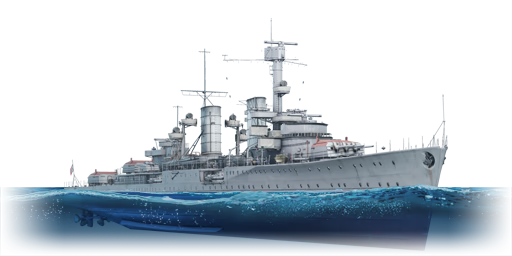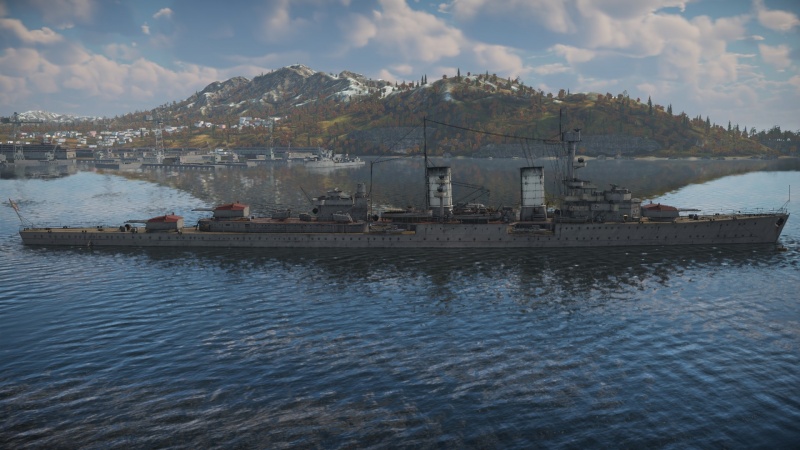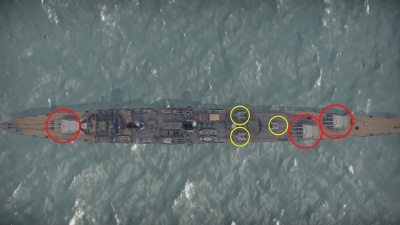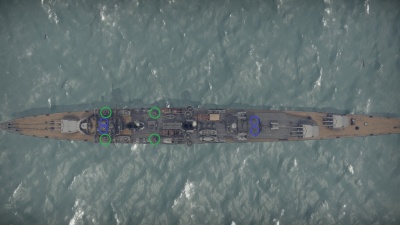Difference between revisions of "Köln"
(Edits) |
(→Ammunition: Converted to transclusion) |
||
| (6 intermediate revisions by 4 users not shown) | |||
| Line 21: | Line 21: | ||
The bridge is covered in 100 mm of cemented armour, giving it enough protection from large calibre HE rounds, but nothing more since even destroyer grade SAP rounds can easily punch right through it, making your ship uncontrollable. | The bridge is covered in 100 mm of cemented armour, giving it enough protection from large calibre HE rounds, but nothing more since even destroyer grade SAP rounds can easily punch right through it, making your ship uncontrollable. | ||
| − | The ammo storage, although decently protected by the belt, | + | The ammo storage, although decently protected by the belt, turtle back and barbette armour, should never be exposed broadside, as all cruisers can penetrate it even from longer ranges. The crew count however, with 820 men, is quite high for a ship this size and helps keeping it afloat and combat ready. |
=== Mobility === | === Mobility === | ||
| Line 27: | Line 27: | ||
<!-- ''Write about the ship's mobility. Evaluate its power and manoeuvrability, rudder rerouting speed, stopping speed at full tilt, with its maximum forward and reverse speed.'' --> | <!-- ''Write about the ship's mobility. Evaluate its power and manoeuvrability, rudder rerouting speed, stopping speed at full tilt, with its maximum forward and reverse speed.'' --> | ||
| − | The Köln has pretty average speed for a light cruiser: | + | The Köln has a pretty average speed for a light cruiser: |
* A top speed of 70 km/h in AB and 60 km/h in RB. | * A top speed of 70 km/h in AB and 60 km/h in RB. | ||
| Line 47: | Line 47: | ||
{{main|15 cm/60 SK C/25 (150 mm)}} | {{main|15 cm/60 SK C/25 (150 mm)}} | ||
| − | The primary armament consists of nine 15 cm/60 SK C/25 cannons mounted in three triple turrets, one central in the front, and two in the rear, slightly off | + | The primary armament consists of nine 15 cm/60 SK C/25 cannons mounted in three triple turrets, one central in the front, and two in the rear, slightly off-centre to the left and to the right. These cannons come with a maximum rate of fire of 8 shots per minute and can fire HE, SAPBC, APCBC and time-fused HE shells. These shells are the same as on the [[Emden]] so most captains will be familiar with these: |
* HE: mostly useful against destroyers | * HE: mostly useful against destroyers | ||
| Line 55: | Line 55: | ||
* APCBC: for more heavily armoured cruisers like [[Admiral Hipper]], [[USS Brooklyn]] and [[IJN Mogami]]. It should be noted however that the APCBC is only useful at medium ranges, everything over 8,000 m which isn't broadside is very difficult to damage. | * APCBC: for more heavily armoured cruisers like [[Admiral Hipper]], [[USS Brooklyn]] and [[IJN Mogami]]. It should be noted however that the APCBC is only useful at medium ranges, everything over 8,000 m which isn't broadside is very difficult to damage. | ||
| − | Their muzzle velocity is uniform with a quick 960 m/s, therefore slightly easier to aim than other contemporary cruisers. | + | Their muzzle velocity is uniform between the HE and APCBC rounds with a quick 960 m/s and between the HE-TF and SAPBC rounds with 835 m/s, therefore slightly easier to aim than other contemporary cruisers. |
Important to mention is that the rear turrets are a full 360° traversable, giving the Köln the ability to focus at least two turrets at a target at all times. | Important to mention is that the rear turrets are a full 360° traversable, giving the Köln the ability to focus at least two turrets at a target at all times. | ||
| + | |||
| + | {{:15 cm/60 SK C/25 (150 mm)/Ammunition|15 cm Spgr. L/4.5 Kz (m.Hb), 15 cm Spgr. L/4.4 Bdz (m.Hb), 15 cm Spgr. L/4.5 Zt.Z, 15 cm Pzgr. L/3.7 (m.Hb)}} | ||
=== Secondary armament === | === Secondary armament === | ||
| Line 64: | Line 66: | ||
{{main|8.8 cm/76 SK C/32 (88 mm)}} | {{main|8.8 cm/76 SK C/32 (88 mm)}} | ||
| − | + | Secondary weapons are composed of a total of three twin-mounted 8.8 cm anti-air cannons with a maximum fire rate of 20 shots per minute. Shells available are HE shells for destroyer and PT boat fights as well as time-fused HE shells which are useful for long range anti-aircraft fire. | |
| + | |||
| + | {{:8.8 cm/76 SK C/32 (88 mm)/Ammunition|Sprgr. L/4.5, 8.8 cm Sprgr. L/4.5 Zt.Z}} | ||
=== Anti-aircraft armament === | === Anti-aircraft armament === | ||
| Line 70: | Line 74: | ||
<!-- ''An important part of the ship's armament responsible for air defence. Anti-aircraft armament is defined by the weapon chosen with the control <code>Select anti-aircraft weapons</code>. Talk about the ship's anti-air cannons and machine guns, the number of guns and their positions, their effective range, and about their overall effectiveness – including against surface targets. If there are no anti-aircraft armaments, remove this section.'' --> | <!-- ''An important part of the ship's armament responsible for air defence. Anti-aircraft armament is defined by the weapon chosen with the control <code>Select anti-aircraft weapons</code>. Talk about the ship's anti-air cannons and machine guns, the number of guns and their positions, their effective range, and about their overall effectiveness – including against surface targets. If there are no anti-aircraft armaments, remove this section.'' --> | ||
[[File:Köln 37mm20mm.jpg|thumb|400x400px|The location of the 37 mm (green) and 20 mm (blue) emplacements.]] | [[File:Köln 37mm20mm.jpg|thumb|400x400px|The location of the 37 mm (green) and 20 mm (blue) emplacements.]] | ||
| − | {{main| | + | {{main|SK C/30 (37 mm)|2 cm/65 C/30 (20 mm)}} |
| − | Anti-air defences are composed of four 3.7 cm twin mountings with a | + | Anti-air defences are composed of four 3.7 cm twin mountings with a fire rate of 30 rounds per seconds, but only firing HE shells, therefore only providing protection from slow moving planes like bombers, and four 20 mm autocannons in single mountings, generally useful for close range anti-air defence, but considering the low number of emplacements for such a large ship, not sufficient in most cases. |
=== Additional armament === | === Additional armament === | ||
| Line 79: | Line 83: | ||
{{main|G7a (533 mm)}} | {{main|G7a (533 mm)}} | ||
| − | The Köln has the ability to deploy up to twelve standard G7a torpedoes in four triple mounts, two of them mounted per side. Limited use for screening of | + | The Köln has the ability to deploy up to twelve standard G7a torpedoes in four triple mounts, two of them mounted per side. Limited use for screening of choke points and narrow water straits, but typically the range at which cruisers slug it out is too great to make use of them. |
== Usage in battles == | == Usage in battles == | ||
<!-- ''Describe the technique of using this ship, the characteristics of her use in a team and tips on strategy. Abstain from writing an entire guide – don't try to provide a single point of view, but give the reader food for thought. Talk about the most dangerous opponents for this vehicle and provide recommendations on fighting them. If necessary, note the specifics of playing with this vehicle in various modes (AB, RB, SB).'' --> | <!-- ''Describe the technique of using this ship, the characteristics of her use in a team and tips on strategy. Abstain from writing an entire guide – don't try to provide a single point of view, but give the reader food for thought. Talk about the most dangerous opponents for this vehicle and provide recommendations on fighting them. If necessary, note the specifics of playing with this vehicle in various modes (AB, RB, SB).'' --> | ||
| − | The Köln is a fun all round light cruiser with usable armour, a good amount of guns, decent fire rate and excellent firing angles. The most important aspect with this ship is to always angle, never ever show your broadside, as this gives enemies an easy shot for your rear ammo racks. By angling this chance is minimized, albeit not fully avoidable. | + | The Köln is a fun all round light cruiser with usable armour, a good amount of guns, decent fire rate and excellent firing angles. The most important aspect with this ship is to always angle, never ever show your broadside, as this gives enemies an easy shot for your rear ammo racks. By angling, this chance is minimized, albeit not fully avoidable. |
| − | Even though the turrets move relatively slowly, this disadvantage is negated by the fully traversable rear turrets, giving the Köln the ability to switch directions easily from one side to the other without losing most of its firepower. However, the firing angles when facing to starboard are better by a few degrees than to port, due to the non central placement of the X and Y turret. Early light cruisers can be engaged by around 8,000 – 10,000 m, whereas more heavily armed and armoured ships like the Admiral Hipper and USS Brooklyn can effectively be dealt with when they face full broadside to you, or by closing the distance to around 5,000 – 6,000 m. | + | Even though the turrets move relatively slowly, this disadvantage is negated by the fully traversable rear turrets, giving the Köln the ability to switch directions easily from one side to the other without losing most of its firepower. However, the firing angles when facing to starboard are better by a few degrees than to port, due to the non-central placement of the X and Y turret. Early light cruisers can be engaged by around 8,000 – 10,000 m, whereas more heavily armed and armoured ships like the Admiral Hipper and USS Brooklyn can effectively be dealt with when they face full broadside to you, or by closing the distance to around 5,000 – 6,000 m. |
| − | Lastly you should always be aware that you are not the top dog in most cases, so careful aiming and smart decision making is important or your ship will succumb to the firepower of more powerful ships. | + | Lastly, you should always be aware that you are not the top dog in most cases, so careful aiming and smart decision-making is important, or your ship will succumb to the firepower of more powerful ships. |
=== Pros and cons === | === Pros and cons === | ||
| Line 116: | Line 120: | ||
;Skins | ;Skins | ||
| + | |||
* [https://live.warthunder.com/feed/camouflages/?vehicle=germ_cruiser_koln Skins and camouflages for the {{PAGENAME}} from live.warthunder.com.] | * [https://live.warthunder.com/feed/camouflages/?vehicle=germ_cruiser_koln Skins and camouflages for the {{PAGENAME}} from live.warthunder.com.] | ||
| Line 123: | Line 128: | ||
== See also == | == See also == | ||
''Links to articles on the War Thunder Wiki that you think will be useful for the reader, for example:'' | ''Links to articles on the War Thunder Wiki that you think will be useful for the reader, for example:'' | ||
| + | |||
* ''reference to the series of the ship;'' | * ''reference to the series of the ship;'' | ||
* ''links to approximate analogues of other nations and research trees.'' | * ''links to approximate analogues of other nations and research trees.'' | ||
Latest revision as of 15:25, 4 March 2023
| This page is about the German light cruiser Köln. For the frigate, see Köln F220. |
Contents
Description
The К-class, Köln, 1940 is a rank German light cruiser with a battle rating of (AB), (RB), and (SB). It was introduced in Update 1.85 "Supersonic".
General info
Survivability and armour
The Köln features decent all around armour with a belt of 50 mm steel covering the most of the ship except the very front and rear, as well as a 10 mm turtleback armour behind it, giving it a slightly better internal protection in close to medium ranges, additionally the bulkheads measure 70 mm of armour. The turrets are a maximum of 30 mm on the front, as are the barbettes, so knockouts of turrets and ammo elevators are common.
The bridge is covered in 100 mm of cemented armour, giving it enough protection from large calibre HE rounds, but nothing more since even destroyer grade SAP rounds can easily punch right through it, making your ship uncontrollable.
The ammo storage, although decently protected by the belt, turtle back and barbette armour, should never be exposed broadside, as all cruisers can penetrate it even from longer ranges. The crew count however, with 820 men, is quite high for a ship this size and helps keeping it afloat and combat ready.
Mobility
The Köln has a pretty average speed for a light cruiser:
- A top speed of 70 km/h in AB and 60 km/h in RB.
- A top reverse speed of 25 km/h in AB and 22 km/h in RB.
As for the manoeuvrability, since it is a cruiser it is quite sluggish, but this is to be expected, therefore narrow turns and fast dodging of torpedoes is not possible.
| Mobility Characteristics | |||
|---|---|---|---|
| Game Mode | Upgrade Status | Maximum Speed (km/h) | |
| Forward | Reverse | ||
| AB | |||
| Upgraded | |||
| RB/SB | |||
| Upgraded | |||
Modifications and economy
Armament
Primary armament
The primary armament consists of nine 15 cm/60 SK C/25 cannons mounted in three triple turrets, one central in the front, and two in the rear, slightly off-centre to the left and to the right. These cannons come with a maximum rate of fire of 8 shots per minute and can fire HE, SAPBC, APCBC and time-fused HE shells. These shells are the same as on the Emden so most captains will be familiar with these:
- HE: mostly useful against destroyers
- SAPBC: can also be utilized against destroyers and for lightly armoured cruisers such as USS Trenton, IJN Agano, USS Portland.
- APCBC: for more heavily armoured cruisers like Admiral Hipper, USS Brooklyn and IJN Mogami. It should be noted however that the APCBC is only useful at medium ranges, everything over 8,000 m which isn't broadside is very difficult to damage.
Their muzzle velocity is uniform between the HE and APCBC rounds with a quick 960 m/s and between the HE-TF and SAPBC rounds with 835 m/s, therefore slightly easier to aim than other contemporary cruisers.
Important to mention is that the rear turrets are a full 360° traversable, giving the Köln the ability to focus at least two turrets at a target at all times.
| Penetration statistics | |||||||
|---|---|---|---|---|---|---|---|
| Ammunition | Type of warhead |
Penetration @ 0° Angle of Attack (mm) | |||||
| 1,000 m | 2,500 m | 5,000 m | 7,500 m | 10,000 m | 15,000 m | ||
| Spgr. L/4.5 Kz (m.Hb) | HE | 37 | 37 | 37 | 37 | 37 | 37 |
| Spgr. L/4.4 Bdz (m.Hb) | SAPBC | 115 | 97 | 74 | 57 | 45 | 35 |
| Spgr. L/4.5 Zt.Z | HE-TF | 37 | 37 | 37 | 37 | 37 | 37 |
| Pzgr. L/3.7 (m.Hb) | APCBC | 289 | 245 | 187 | 144 | 112 | 77 |
| Shell details | ||||||||||||
|---|---|---|---|---|---|---|---|---|---|---|---|---|
| Ammunition | Type of warhead |
Velocity (m/s) |
Projectile mass (kg) |
Fuse delay (s) |
Fuse sensitivity (mm) |
Explosive mass (TNT equivalent) (kg) |
Ricochet | |||||
| 0% | 50% | 100% | ||||||||||
| Spgr. L/4.5 Kz (m.Hb) | HE | 960 | 45.5 | 0 | 0.1 | 3.64 | 79° | 80° | 81° | |||
| Spgr. L/4.4 Bdz (m.Hb) | SAPBC | 835 | 45.5 | 0.015 | 7 | 3.03 | 48° | 63° | 71° | |||
| Spgr. L/4.5 Zt.Z | HE-TF | 835 | 44.8 | 0 | 0.1 | 3.64 | 79° | 80° | 81° | |||
| Pzgr. L/3.7 (m.Hb) | APCBC | 960 | 45.5 | 0.015 | 7 | 1.1 | 48° | 63° | 71° | |||
Secondary armament
Secondary weapons are composed of a total of three twin-mounted 8.8 cm anti-air cannons with a maximum fire rate of 20 shots per minute. Shells available are HE shells for destroyer and PT boat fights as well as time-fused HE shells which are useful for long range anti-aircraft fire.
| Penetration statistics | |||||||
|---|---|---|---|---|---|---|---|
| Ammunition | Type of warhead |
Penetration @ 0° Angle of Attack (mm) | |||||
| 100 m | 1,000 m | 2,000 m | 3,000 m | 4,000 m | 5,000 m | ||
| Sprgr. L/4.5 | HE | 11 | 11 | 11 | 11 | 11 | 11 |
| Sprgr. L/4.5 Zt.Z | HE-TF | 11 | 11 | 11 | 11 | 11 | 11 |
| Shell details | ||||||||||||
|---|---|---|---|---|---|---|---|---|---|---|---|---|
| Ammunition | Type of warhead |
Velocity (m/s) |
Projectile mass (kg) |
Fuse delay (m) |
Fuse sensitivity (mm) |
Explosive mass (TNT equivalent) (g) |
Ricochet | |||||
| 0% | 50% | 100% | ||||||||||
| Sprgr. L/4.5 | HE | 950 | 9 | 0 | 0.1 | 698 | 79° | 80° | 81° | |||
| Sprgr. L/4.5 Zt.Z | HE-TF | 950 | 9 | 0 | 0.1 | 698 | 79° | 80° | 81° | |||
Anti-aircraft armament
Anti-air defences are composed of four 3.7 cm twin mountings with a fire rate of 30 rounds per seconds, but only firing HE shells, therefore only providing protection from slow moving planes like bombers, and four 20 mm autocannons in single mountings, generally useful for close range anti-air defence, but considering the low number of emplacements for such a large ship, not sufficient in most cases.
Additional armament
The Köln has the ability to deploy up to twelve standard G7a torpedoes in four triple mounts, two of them mounted per side. Limited use for screening of choke points and narrow water straits, but typically the range at which cruisers slug it out is too great to make use of them.
Usage in battles
The Köln is a fun all round light cruiser with usable armour, a good amount of guns, decent fire rate and excellent firing angles. The most important aspect with this ship is to always angle, never ever show your broadside, as this gives enemies an easy shot for your rear ammo racks. By angling, this chance is minimized, albeit not fully avoidable.
Even though the turrets move relatively slowly, this disadvantage is negated by the fully traversable rear turrets, giving the Köln the ability to switch directions easily from one side to the other without losing most of its firepower. However, the firing angles when facing to starboard are better by a few degrees than to port, due to the non-central placement of the X and Y turret. Early light cruisers can be engaged by around 8,000 – 10,000 m, whereas more heavily armed and armoured ships like the Admiral Hipper and USS Brooklyn can effectively be dealt with when they face full broadside to you, or by closing the distance to around 5,000 – 6,000 m.
Lastly, you should always be aware that you are not the top dog in most cases, so careful aiming and smart decision-making is important, or your ship will succumb to the firepower of more powerful ships.
Pros and cons
Pros:
- Excellent firing angles
- Sufficient protection against light cruisers when angled
- High penetrating AP rounds suitable against most targets
- 360° traversable rear turrets
Cons:
- With only one frontal turret, head-on engagements can be somewhat difficult
- Vulnerable broadside
- Thinly armoured turrets, easy to knock out
- Insufficient AA battery
History
KMS Köln was laid down in August 1926 in Wilhelmshaven as the third and final ship of the Königsberg-class of German light cruisers. Köln was ordered as a replacement for the old SMS Arcona light cruiser and was launched in May 1928, before being commissioned into service in January 1930. Her first years of service, KMS Köln spent undergoing various sea trials and acted as a training ship. In late 1932 however, the warship departed Germany for her first world cruise, stopping in numerous ports across the globe in the Atlantic, Pacific and Indian Ocean, as well as the Mediterranean Sea. Prior to the outbreak of WW2, KMS Köln took part in non-intervention patrols around the Iberian Peninsula during the Spanish Civil War. Upon completing her patrol missions, KMS Köln returned to the waters of the North Sea in order to conduct fishery protection. During WW2, KMS Köln primarily operated in the waters of the North and Baltic Seas, whilst occasionally taking part in operations in the Atlantic. Most notably, KMS Köln took part in Operation Weserübung in 1940 - the German Invasion of Norway. During this operation, both of her two sister ships were lost in combat, whilst Köln remained undamaged. Throughout the remainder of WW2, KMS Köln primarily took part in operations in the North Sea, mostly in Norwegian waters, running convoy interdiction and minelaying. In December 1944, KMS Köln suffered damage to her propulsion system caused by several near misses inflicted by allied bombers, close to Oslofjord. The damage forced her to return for repairs to Germany, where she eventually ended up in Wilhelmshaven again. There, an allied air raid damaged Köln further and led her to sink on an even keel. Only partially sunk and with the guns still operational, she was used as an artillery platform to help defend the city before the war ended. Although partially dismantled after the war, Köln was raised in 1956 and scuttled soon afterwards.
- From Devblog
Media
- Skins
- Videos
See also
Links to articles on the War Thunder Wiki that you think will be useful for the reader, for example:
- reference to the series of the ship;
- links to approximate analogues of other nations and research trees.
External links
| Kriegsmarinewerft Wilhelmshaven | |
|---|---|
| Torpedo Boats | |
| Raubtier-class | Jaguar · Leopard · Luchs |
| Light Cruisers | |
| K-class | Köln |
| Leipzig-class | Leipzig |
| Unique Ships | Emden |
| Heavy Cruisers | |
| Deutschland-class | Admiral Graf Spee |
| Battleships | |
| Scharnhorst-class | Scharnhorst |
| See also | Kaiserliche Werft (1871 - 1918) |
| Germany light cruisers | |
|---|---|
| Pillau-class | SMS Elbing |
| Emden* | |
| Königsberg-class | Karlsruhe · Köln |
| Leipzig-class | Leipzig · Nürnberg |
| * Unique ship | |







